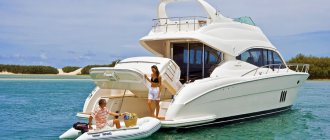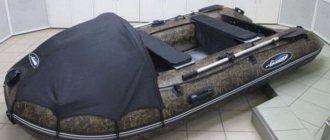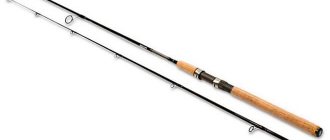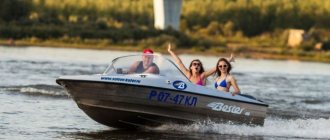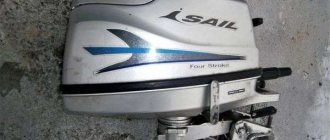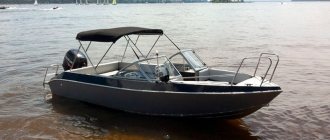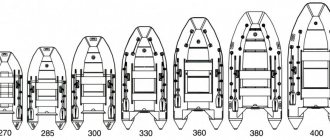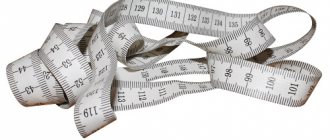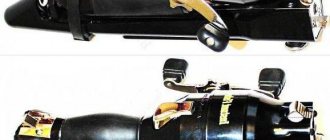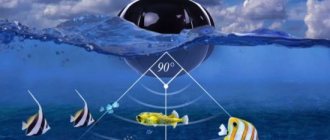Which boats are better: PVC or rubber?
You can’t say that right away. This is a very difficult question. There are fans of PVC boats, and there are those who are in favor of inflatable rubber boats. This is an age-old dispute between two camps of fishermen. Both options are quite common, and both options can be found in a wide range in specialized stores.
The first thing that comes to mind is to compare their practicality. Compactness is about inflatable, rubber boats. PVC is bulky. PVC is a material that, with the same volume of boats, will fold more voluminously. In this aspect, victory is for the rubber.
The next point is storage. In this case, the answer to the question regarding which boats are better: PVC or rubber, the PVC option will win. Since a rubber boat cannot, for example, be stored folded all winter, it must be hung and other manipulations carried out with it. A PVC boat can be stored without any problems; there is no need to shift it or perform any other tricky movements with it.
But to find the truth, you need to take a more specific look at each type of boat.
Main features of PVC boats
PVC inflatable boats are made from multi-layer fabric, glued and coated on both sides with polyvinyl chloride. This material has increased mechanical strength and chemical resistance to harmful environmental factors.
The main indicator is the density of the fabric. For good boats, only high quality material is used with a density of 750 to 1200 grams per square meter . The greater the density of the fabric, the higher its resistance to tearing. It is not easy to damage the side or bottom of a boat made of heavy, high-quality fabric. But, in exchange for this unique property, the consumer has to put up with the increased weight of the products, difficulties during installation and transportation.
Advantages of PVC boats:
- Easy to maintain , the fabric of the boat is not subject to rotting processes, is not afraid of dampness, dust, and dirt.
- Relatively small mass of the product in relation to its size.
- High strength , allowing the vessel to be used in conditions close to extremes, at high and low temperatures.
- Good load capacity with compact dimensions.
- Ability to prepare for swimming without assistance.
- Increased stability against rollover.
- Almost complete absence of sediment, ease of overcoming shallow waters and areas with floating aquatic vegetation.
- Possibility of long-term storage when folded.
- Undemanding to special storage conditions.
Properties of PVC fabric
The material for PVC boats is special. Unlike rubber materials, PVC fabric is much lighter, and at the same time it does not rot and does not absorb moisture. In addition, the material is not afraid of frost and is not exposed to fungi and other microorganisms. Compared to rubber boats, PVC fishing boats are more practical. Due to the fact that PVC can be used in a wider temperature range, this is undoubtedly a plus.
There is one more point when rubber boats lose: PVC for a motor is an ideal option, because this material is not afraid of an aggressive environment (gasoline, motor oil, etc.). Also, PVC materials are not afraid of ultraviolet radiation. Those who have a rubber boat know that rubber cracks when exposed to the rays of the sun.
But there are times when a PVC boat loses. This is the price and repairs. A rubber boat is easier to repair. The price of rubber boats is always significantly lower, although recently PVC options have appeared that cost almost the same as their rubber counterparts. These are the simplest models.
Also, do not forget that if you are a smoker, then any cigarette butt can make a big hole in your PVC boat; in the case of rubber, trouble will not happen so quickly.
PVC boats are made from special reinforced fabric, which has several layers. The layers are woven together with special fibers, and the outer layer is covered with a special coating of polyvinyl chloride.
Why is PVC better than rubber?
Why is a PVC boat better than a rubber boat?
PVC - Polyvinyl chloride. Colorless, transparent plastic, thermoplastic vinyl chloride polymer. It is chemically resistant to alkalis, mineral oils, many acids and solvents. Does not burn in air and has low frost resistance (-15 °C). Heat resistance: +65 °C.
Chemical formula: [-CH2-CHCl-]n. International designation PVC (description from Wikipedia).
1. Transportation
Both boats easily fold into a compact bag for transport. But there is a noticeable difference in weight. The fact is that rubber is one and a half (1.5) times heavier than PVC! If, for example, a boat made of rubber weighs 16 kg, then the same boat made of PVC will weigh 11 kg. Agree, this is very noticeable.
2. Operation A PVC boat can withstand much more pressure than a rubber one. Therefore, PVC boats are more rigid and load-bearing. Thanks to its “dense” inflation, a PVC boat acquires high seaworthiness, for example, when using a motor, it improves its ability to ride waves, and when using oars, it makes movement easier.
And also, from our own experience. We offer our boats for sale in several stores in Ufa. The same stores also sell rubber boats. So, sellers have to pump up rubber boats every day, while PVC sits for weeks and does not lose pressure. Thus, we draw a practical conclusion that PVC material is denser and does not bleed air, as happens with rubber.
3. Maintainability PVC boats are resistant to salt water, fuel, oils, and ultraviolet radiation, but the same cannot be said about rubber boats. In addition, PVC fabric is puncture-resistant - this is due to the fact that the design is based on cord fabric, which significantly strengthens the structure and allows you to quickly and effortlessly get rid of a puncture, even on water. PVC boats come with a repair kit (first aid kit), which allows you to quickly get rid of damage.
For a long time there was a myth that PVC cannot be repaired. This is related to the Chinese counterparts of rubber boats. They are made from PVC rubber, not PVC fabric. Boats made of PVC rubber can come apart even due to sunlight, and there is no point in repairing them at all.
4. Packing after use Let’s say something urgent happened after fishing or a boat trip and you don’t have time to dry and clean the boat. With a PVC boat everything is simple - you roll it up, put it in a bag and you can run, but with a rubber boat everything is completely different, because rubber needs care. It needs to be wiped and dried. PVC fabrics are resistant to decay and decay.
5. Preparation for storage for the winter Sooner or later winter comes and the boat has to be hidden away in the garage or on the mezzanine at home. What is easier to prepare for long-term storage: a PVC boat or a rubber one?
A rubber boat requires special care. Before putting it on the far shelf, you will have to dry it and treat it with talcum powder. In addition, you need to store a rubber boat at above-zero temperatures so that the rubber does not deteriorate. What about the PVC boat? Actually, you don’t need to do anything. PVC fabric is resistant to temperatures and environmental influences, so you can simply roll it up and take it to the garage. And next summer you will get a high-quality boat that has not lost any properties. Please note: PVC storage temperature ranges from -40 degrees Celsius to +70.
6. What is more aesthetically pleasing: PVC or rubber? On PVC boats you will not see irregular shapes, stains from talc or varnish, or “smears” from glue on the seams and under the tapes. Since competition in the boat market is high, in the struggle for quality, the equipment is also improved, adding various reinforcements, supplying convenient and high-quality fittings, convenient bags, lightweight collapsible oars, rotary oarlocks, etc. With us, for example, you can configure your boat to suit your individual order.
We have looked at the important aspects of boat operation and can now make our choice.
Boats are also made from a number of other materials, but their cost is high, so such boats are rare and are used mainly for specialized tasks.
Features of rubber boats
Continuing to search for the truth in the question of which inflatable boat is better: rubber or PVC, it would be correct to talk about the properties of classic “rubber bands”. An important point of such boats is the base, which is subsequently rubberized.
Rubber is just a shell that protects against water and makes the product airtight. The entire strength of the boat depends only on the foundation.
Over the years, the fabric rots and the rubber cracks. The service life of such a boat is within ten years, sometimes such boats last longer, but each sailing on them may be the last for this “vessel”. Also, when you use the rubber band, you always need to monitor the pressure in the cylinders. If it’s hot outside, then over-inflated cylinders can burst, this is a real fact, such cases have been recorded. This is most often noticed on boats that have already served for ten or more years.
The basis of a rubber boat is a multi-layer fabric (cotton or synthetic). The base is covered with rubber on both sides. Each side is made of two or more layers of rubber combined with neoprene. If you operate such a boat at sea, the rubber layer will peel off from the cord very quickly. It is worth saying that in freshwater bodies such problems are also possible, although less common. After using such a boat, you need to dry it well, reposition it from time to time and remove any detected moisture to avoid the formation of mold and destruction of the entire product.
Ideally, rubber boats should be stored at home (at room temperature); this is also not always convenient, especially if the apartment is not too spacious.
Boat dynamics
Which boats are better: PVC or rubber? There is no answer, because the dynamics of your boat depends solely on the shape of its bottom, and not on the material it is made of. The fastest boats have an inflatable bottom (payols); they experience almost no water resistance when moving. Sometimes the bottom is made of aluminum or carbon. These options are also good. All of the listed types of bottom are better than the so-called sagging classic bottom.
Types of PVC boats
Rowing
These are small boats designed for one or two people. They are used by fishermen to swim to the middle of the lake or move along a calm river.
Moving is carried out exclusively by oars, so the application area has distance restrictions. But you can also use it to descend from a mountain river, provided that there are no steep or sharp rapids (sports tourism).
Advantages:
- Affordable price;
- Light weight;
- Oars included;
- Can be transported in a carrying case by hand;
- Inflates quickly with a pump.
Flaws:
- Low load capacity;
- May capsize in high waves;
- There is nowhere to mount the motor;
- Many models without a keel.
Motor
They come in a variety of sizes that can accommodate anywhere from two to eight people. The tails of the cylinders at the stern protrude far beyond the bottom, which gives high buoyancy and the correct position of the hull at maximum engine speeds.
The motor is mounted on a standard transom seat. Boats are used for sea trips, trolling, and water attractions.
Advantages:
- Fast movement on water;
- More durable structures in terms of rigidity;
- Independent air compartments;
- Hard floor;
- There is a keel;
- Large selection of power units by power.
Flaws:
- Expensive;
- They weigh a lot;
- Time-consuming assembly of all parts before use.
Motor-rowing with mounted transom
Such boats are distinguished by blunter hull shapes, which does not allow them to develop high speed, but movement is possible either by oar or by using the motor blades.
The latter is mounted on a rigid panel at the rear, but can, if desired, be detached and used without a power unit. This species is widely used for fishing, hunting or boat trips.
Advantages:
- Various length sizes;
- Sufficient buoyancy;
- Equipped with medium-power motors;
- Can be used without a motor;
- Compact dimensions for transportation;
- Thick PVC fabric.
Flaws:
- Usable luggage space depends on the diameter of the cylinders;
- Not suitable for interaction with powerful motors.
Comfort
The most comfortable models are PVC boats with a rigid, thick hull. They are much more comfortable than thin-walled hard-walled PVC boats or rubber options. The price of the boats corresponds to their level of comfort. There are very budget “rubber bands”, and there are very expensive PVC boats, but they are very comfortable to use. The choice is yours.
Choice
Which boats are better: PVC or rubber? Which one to choose? The choice must be made not only based on the material, but other aspects must also be taken into account. Consider the size of the body of water where you will be fishing. Also important are the fishing conditions and the number of people in the boat.
Today the market is extremely saturated with a wide variety of types of boats from this category. Make a choice based on your financial capabilities first, and only then look for the answer to the question which concerns which boats are better: PVC or rubber?
Recommendations for selection
The first point is the peculiarity of the reservoir. For fishing in shallow water (pond, reeds, bay, quiet river, etc.), cheap, simple rubber rowing boat models are suitable; you can consider domestic options.
For fishing in large waters (reservoirs, large turbulent rivers, lakes, seas, etc.), it is better to give preference to PVC boats with a transom, that is, those boats on which you can install a motor.
For active extreme fishing, choose models that are durable and of high quality. The entire hull of your boat must be rigid for such purposes. The ideal option is boats with a bulwark. The number of cylinders also plays an important role. The more there are, the more reliable and safe it is to travel by boat.
Also pay attention to the performance of your future boat and its stability on the water. But how to do this before purchasing? If only you test the boats of other fishing enthusiasts you know. It is advisable to choose models with an inflatable or hard bottom, but they will always cost more than options with a regular bottom.
Comparative differences
Although the products are externally similar, they have a number of significant differences in the most popular consumer parameters. The main data is presented in the table below.
| Rubber boat | PVC boat |
| The material has insufficient resistance to mechanical stress | The fabric of the product has increased mechanical strength and is resistant to tearing and punctures. |
| Low chemical resistance of matter to aggressive natural factors, incl. solar radiation | The material has high chemical and mechanical resistance to environmental factors |
| Only short-term use of the product in sea water is permissible. | Permanent operation of the product in sea water is acceptable |
| Increased demands on storage conditions and regime | Does not require special storage conditions |
| Swimming in ice conditions is not acceptable | Navigation in ice conditions is allowed (for products made of particularly durable material) |
| It is unacceptable for gasoline and oil to come into contact with the boat material. | The fabric of the boat is not susceptible to the harmful effects of hydrocarbons |
| The matter weakly resists rupture when heated in the sun. Requires constant adjustment of air pressure in cylinders | Has a high level of tensile strength under significant sudden temperature changes |
| In conditions of comparable dimensions, the mass of such a product is less | In conditions of comparable dimensions, the mass of such a product is greater |
| Dimensions and weight in the stacked state are smaller (if the operational size is comparable) | Dimensions and weight in the stacked state are larger (if the operational size is comparable) |
| Easy to assemble, disassemble, lay in any temperature conditions | Difficult assembly, disassembly, installation at low temperatures. Performing these operations in the cold is unacceptable, as it can lead to tissue fracture along tight folds, fracture lines, and bends. |
| Affordable price | High cost of products |
| Sufficient resistance to sparks (no contact with open flame) | Instant burning of plastic fabric from a spark, cigarette, or open fire. Requires increased attention when leaving the product near a fire, while smoking, during forest fires, burning grass, etc. |
Owner reviews
Fishermen leave positive reviews about both rubber and PVC boats. Regarding rubber products, they say that you need to carefully care for your boat and store it properly, in which case it will serve faithfully for a very long time.
PVC boats are characterized as durable and reliable options, their only drawback is their high price. Experienced owners recommend buying rubber (cheaper) boats for occasional fishing trips, and for avid fishermen, PVC options are suitable if you can afford them.
